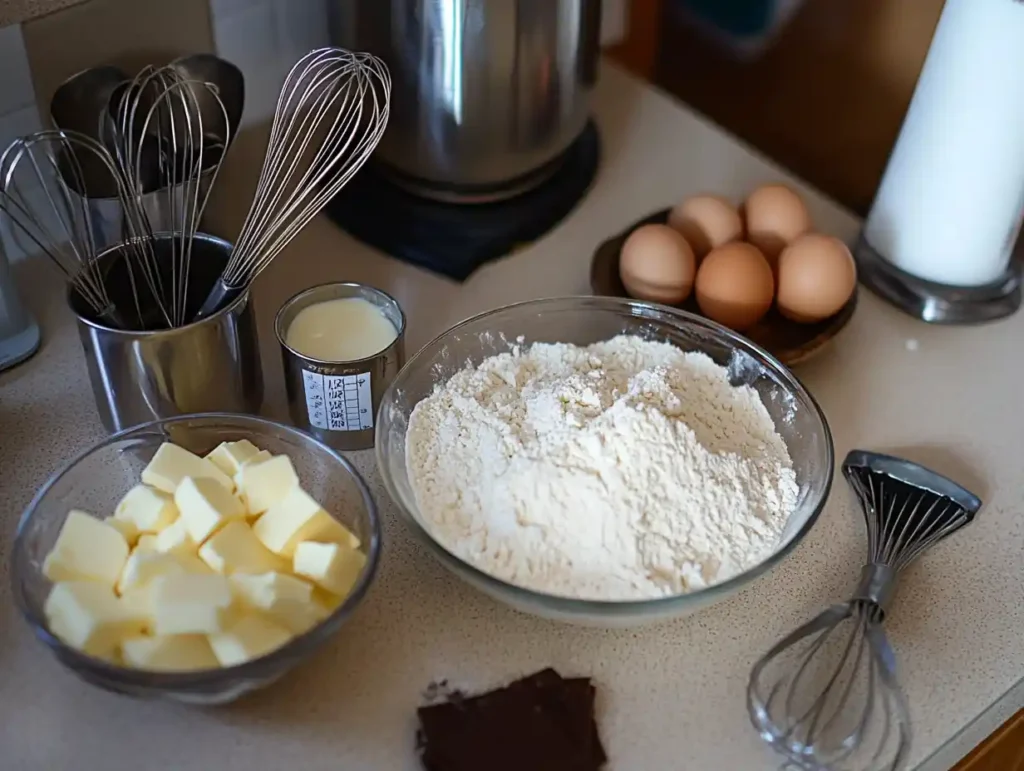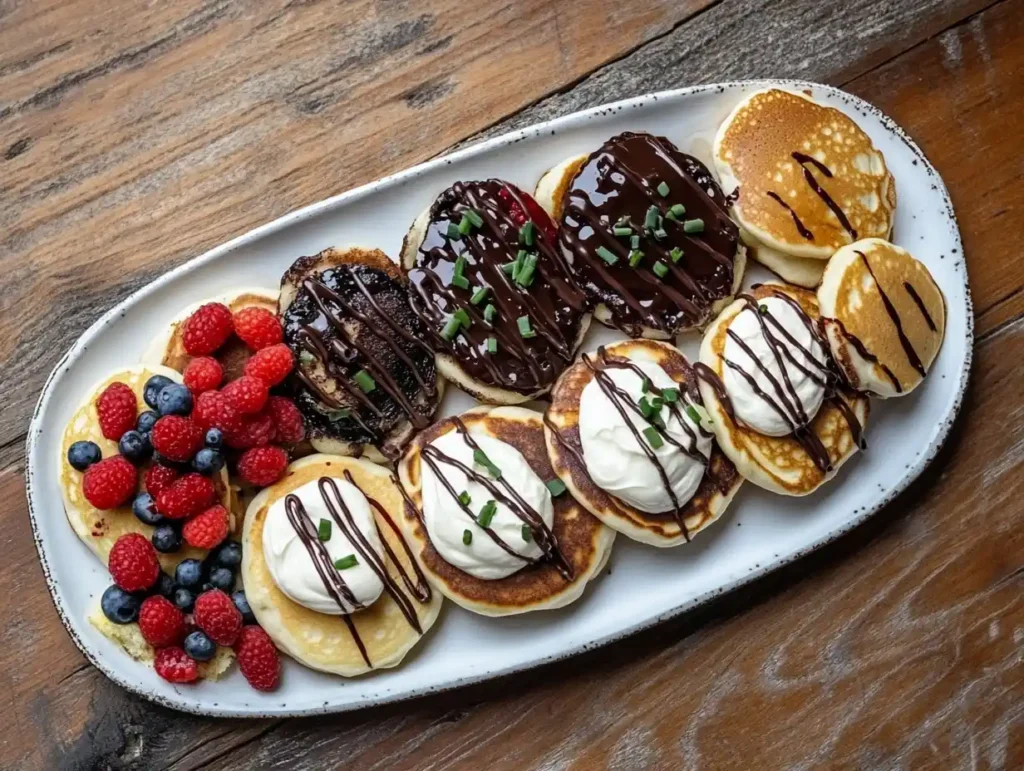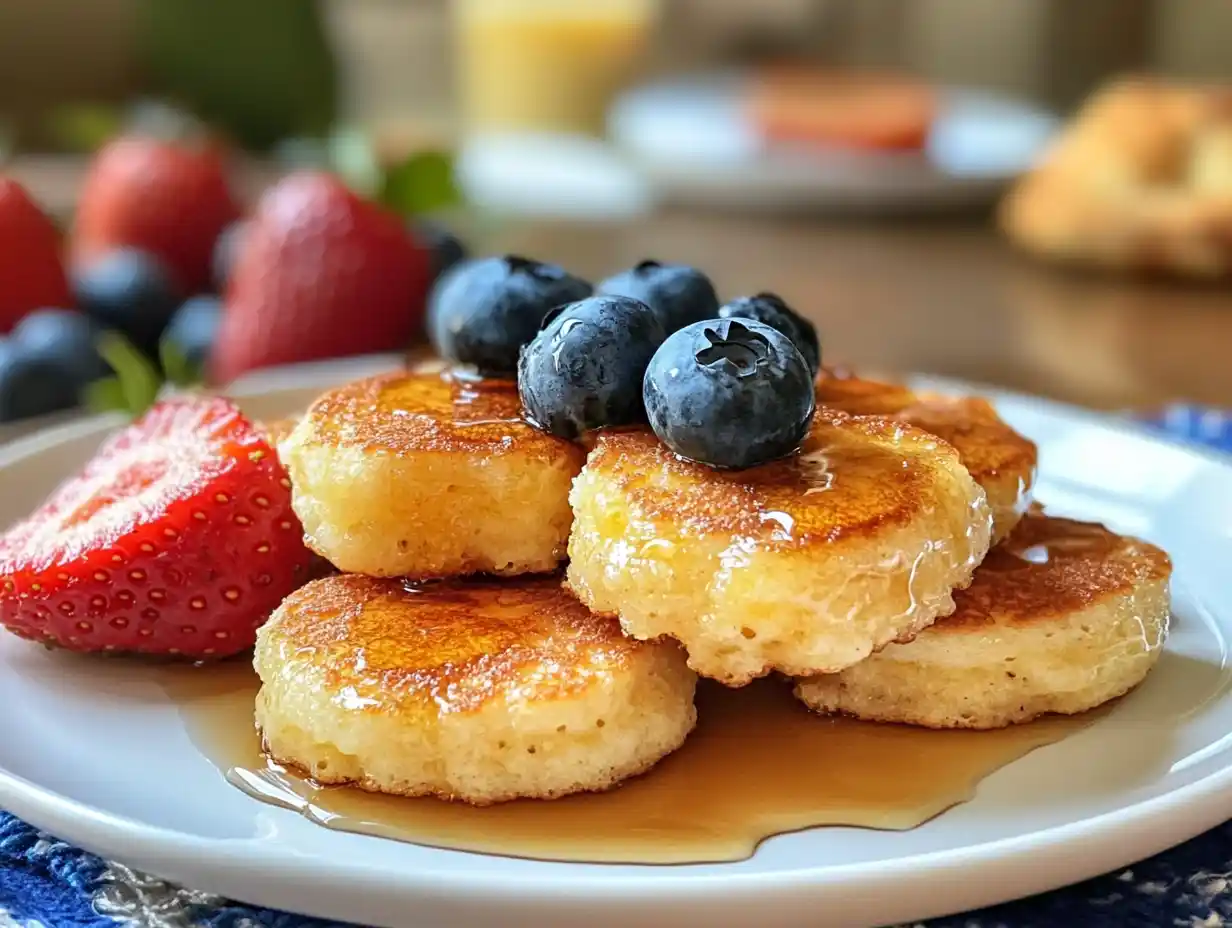Mini pancakes, also known as silver dollar pancakes, are a delightful variation of traditional pancakes that have gained popularity for their adorable size and versatility. Whether served as a breakfast treat, snack, or dessert, these bite-sized delights are perfect for any occasion.
The charm of mini pancakes lies not just in their size but also in the simplicity of their ingredients. From the basic components like flour and eggs to optional add-ins such as vanilla and spices, the recipe offers endless opportunities for customization.
In this article, we’ll break down the key ingredients that go into making mini pancakes, explore flavor variations, and provide tips for preparing them to perfection. Whether you’re a seasoned cook or a beginner in the kitchen, this guide will equip you with all the knowledge you need to whip up a batch of these tasty treats.
The Base Ingredients of Mini Pancakes

The foundation of any great mini pancake recipe lies in its core ingredients. These ingredients create the structure, flavor, and texture that make mini pancakes so enjoyable. Let’s dive into each essential component.
Flour: The Structural Backbone
Flour is the most critical ingredient in mini pancakes. It provides structure and stability to the batter, allowing the pancakes to hold their shape during cooking.
- Types of Flour: All-purpose flour is the go-to choice for most recipes due to its balanced protein content, which ensures a soft yet sturdy pancake. Whole wheat flour can be used for a nuttier flavor and added fiber, but it may result in a denser texture. For gluten-free options, almond flour or a gluten-free all-purpose mix works well.
- The Role of Flour: Flour interacts with the wet ingredients to create a batter with the perfect consistency. It absorbs the liquid, forming a cohesive mixture that can hold air bubbles for fluffiness.
Eggs: The Binder
Eggs are essential for binding the ingredients together and providing structure and moisture. They also contribute to the golden-brown color of mini pancakes.
- What Eggs Do: Eggs stabilize the batter and help it rise during cooking, thanks to their emulsifying properties. The proteins in eggs set when heated, giving the pancakes their soft yet firm texture.
- Egg Substitutes: For those with dietary restrictions, eggs can be replaced with flaxseed meal (1 tablespoon flaxseed meal + 3 tablespoons water per egg) or applesauce for a similar binding effect.
Milk or Buttermilk: Adding Moisture
Milk, or its tangier counterpart buttermilk, plays a vital role in creating a smooth and creamy batter.
- The Role of Milk: Milk adds moisture to the dry ingredients, ensuring the batter has a pourable consistency. Buttermilk, in particular, enhances the tenderness of mini pancakes and provides a slight tangy flavor.
- Alternatives to Milk: Dairy-free options such as almond milk, soy milk, or oat milk can be used as substitutes without compromising the texture.
Sweeteners: Sugar and Alternatives
Sweeteners give mini pancakes their subtle sweetness, making them perfect for pairing with syrups, fruits, or other toppings.
- Traditional Sweeteners: Granulated sugar is commonly used, but brown sugar adds a caramel-like depth of flavor.
- Low-Calorie Alternatives: For a healthier twist, natural sweeteners like honey, maple syrup, or stevia can replace traditional sugar. Adjust the amount to taste, as these alternatives often have different levels of sweetness.
The Base Ingredients of Mini Pancakes
Every mini pancake starts with a few basic ingredients. These form the core of the recipe, giving the pancakes their soft, fluffy texture and delicious taste. Let’s explore these essential components.
Flour: The Key Ingredient for Structure
Flour creates the structure of mini pancakes and helps the batter hold its shape.
- Common Choices: Most recipes use all-purpose flour because it strikes a good balance between softness and strength. Whole wheat flour works too, adding a richer flavor and more nutrients, though it makes the pancakes denser. If you need a gluten-free option, almond flour or a gluten-free blend works great.
- Why It Matters: Flour absorbs the liquid ingredients and helps the batter hold air. This process makes the pancakes light and fluffy.
Eggs: The Ingredient That Brings Everything Together
Eggs play a crucial role in binding the ingredients and making the pancakes soft and tender.
- What They Do: Eggs hold the batter together, give the pancakes moisture, and help them puff up. They also add a nice golden color.
- Egg-Free Options: If you don’t eat eggs, you can replace them with a mix of ground flaxseed and water or a bit of mashed banana.
Milk or Buttermilk: For a Smooth Batter
Milk is vital for making the batter smooth and easy to pour. Buttermilk is another great option, adding a slight tang and extra tenderness.
- Why It’s Important: Milk keeps the dry ingredients from clumping and helps blend everything evenly. Buttermilk adds a bit of flavor and reacts with baking soda to make the pancakes fluffy.
- Dairy-Free Choices: Almond milk, oat milk, or coconut milk work just as well if you avoid dairy.
Sweeteners: Adding a Touch of Flavor
A little sweetness makes mini pancakes more delicious, whether you eat them plain or with toppings.
- Common Options: Regular sugar is popular, but brown sugar gives the pancakes a richer flavor.
- Healthier Alternatives: You can swap sugar for honey, maple syrup, or stevia. Adjust the amount based on how sweet you like your pancakes.
The Base Ingredients of Mini Pancakes
Mini pancakes are made with simple ingredients you likely already have at home. These items work together to create the soft and fluffy texture we all love. Let’s look at each one in detail.
Flour: The Main Building Block
Flour is the most important ingredient. It gives pancakes their shape and holds everything together.
- Common Types: Most people use all-purpose flour because it makes pancakes light and soft. If you want a healthier option, whole wheat flour adds more fiber but can make the pancakes heavier. For gluten-free pancakes, almond flour or a special gluten-free mix works well.
- Why It’s Needed: Flour soaks up the liquid ingredients and helps the batter stay thick enough to hold air. This process makes the pancakes fluffy.
Eggs: Keeping It All Together
Eggs are essential for holding the batter together. They also add flavor and make the pancakes soft.
- How They Work: Eggs mix with the other ingredients to create a smooth batter. They also help the pancakes puff up and give them a golden color.
- Egg Substitutes: If you don’t eat eggs, you can use a mix of ground flaxseed and water or mashed banana instead. These options will still bind the batter together.
Milk or Buttermilk: Adding Smoothness
Milk makes the batter easy to pour, while buttermilk adds a slight tangy flavor and extra softness.
- Why It’s Important: Milk helps the dry ingredients mix evenly and creates a creamy batter. Buttermilk works especially well because it reacts with baking soda to make the pancakes light and airy.
- Non-Dairy Options: If you don’t use dairy, almond milk, soy milk, or oat milk are good alternatives.
Sweeteners: Adding a Hint of Sweetness
Sweeteners make the pancakes taste just a little sweet, even before adding syrup or toppings.
- Popular Choices: Many people use regular sugar or brown sugar. Brown sugar gives the pancakes a slightly richer flavor.
- Healthier Options: You can swap sugar for honey, maple syrup, or even a sugar substitute like stevia. Adjust the amount based on your taste preference.
Additional Ingredients for Flavor and Texture
While the base ingredients are essential, adding a few extra items can take mini pancakes to the next level. These additions enhance the flavor, texture, and overall appeal of the pancakes.
Baking Powder or Baking Soda: The Secret to Fluffiness
Leavening agents like baking powder or baking soda are what make pancakes rise and become fluffy.
- How They Work: These ingredients create tiny bubbles in the batter when they react with the wet ingredients. This process traps air, which makes the pancakes light and soft.
- Choosing the Right One: Baking powder is usually the go-to choice, but if the recipe includes an acidic ingredient like buttermilk, baking soda works better.
Butter or Oil: For Softness and Richness
Fats like butter or oil add moisture and make the pancakes tender.
- The Role of Fats: Butter melts into the batter, adding a rich flavor and smooth texture. Oil, on the other hand, keeps the pancakes moist without altering the taste as much.
- Substitutes: Coconut oil or olive oil can replace butter for a dairy-free option. For a lighter version, you can reduce the fat and use applesauce instead.
Vanilla and Spices: Boosting Flavor
A splash of vanilla extract or a pinch of spice can make mini pancakes even more delicious.
- Vanilla: Vanilla extract adds a warm, sweet aroma that pairs perfectly with the pancakes.
- Spices: A pinch of cinnamon or nutmeg can give your pancakes a cozy flavor, especially if you’re making them during the holidays. You can also add cocoa powder for a chocolatey twist.
Mix-Ins: Personalizing Your Pancakes
Mix-ins are a fun way to customize your mini pancakes and make them more exciting.
- Common Add-Ins: Chocolate chips, blueberries, or chopped nuts are classic choices. You can stir them into the batter or sprinkle them on top while cooking.
- Creative Ideas: Try shredded coconut, dried cranberries, or even sprinkles for a colorful touch.
With these additional ingredients, you can easily adapt your mini pancake recipe to suit your tastes or create unique variations every time.
Specialized Mini Pancake Recipes

Mini pancakes can be tailored to fit a variety of dietary needs and preferences. Whether you’re avoiding gluten, following a vegan diet, or cutting carbs, there’s a recipe for you. Let’s explore some popular variations.
Gluten-Free Mini Pancakes
For those with gluten intolerance or celiac disease, gluten-free mini pancakes are a delicious alternative.
- Flour Substitutes: Use gluten-free all-purpose flour or almond flour as the base. Other options include coconut flour or oat flour, but these may need more liquid since they absorb more moisture.
- Tips for Success: Adding a binding agent like xanthan gum or a bit of extra egg can help create a texture similar to traditional pancakes.
- Flavor Additions: Gluten-free pancakes pair well with fresh fruit, honey, or a sprinkle of cinnamon.
Vegan Mini Pancakes
Vegan pancakes are made without any animal products, yet they are just as tasty and fluffy as regular ones.
- Replacing Eggs and Dairy: Substitute eggs with a flaxseed or chia seed mixture (1 tablespoon of seeds mixed with 3 tablespoons of water for each egg). Replace milk with almond, oat, or soy milk. Coconut milk also works for a richer taste.
- Fats: Use plant-based butter or oil instead of dairy-based butter.
- Flavor Ideas: Enhance the flavor with a splash of vanilla or a pinch of cinnamon. You can also add fruits like mashed bananas or applesauce for sweetness and moisture.
Keto-Friendly Mini Pancakes
If you’re on a low-carb or ketogenic diet, you can still enjoy mini pancakes by swapping out high-carb ingredients.
- Low-Carb Flours: Use almond flour, coconut flour, or a mix of both. These are low in carbs but rich in flavor and texture.
- Sweeteners: Replace sugar with keto-friendly options like erythritol, stevia, or monk fruit sweetener.
- Add-Ins: Mix in unsweetened cocoa powder, sugar-free chocolate chips, or a dash of vanilla extract to add variety.
Protein-Packed Mini Pancakes
For a post-workout treat or a protein boost, you can make high-protein mini pancakes.
- Boosting Protein: Add protein powder to the batter, or use Greek yogurt as one of the liquid ingredients.
- Mix-Ins: Include nuts, seeds, or nut butter for extra protein and crunch.
- Flavor Tips: Vanilla or chocolate protein powders work well to enhance the taste.
Specialized recipes ensure that everyone can enjoy the delight of mini pancakes, no matter their dietary needs.
Frequently Asked Questions
Here are answers to some of the most common questions about mini pancakes, covering preparation, storage, and more.
Can I use pancake mix to make mini pancakes?
Yes, you can use pancake mix to make mini pancakes! Pancake mix simplifies the process since it already contains the dry ingredients like flour, sugar, and leavening agents. Just follow the instructions on the box, but adjust the size of each pancake when pouring the batter. For added flavor, you can still include ingredients like vanilla extract or a pinch of cinnamon.
How do I store leftover mini pancakes?
To store leftover mini pancakes:
- Place them in an airtight container and keep them in the refrigerator for up to 3 days.
- If you need to store them longer, freezing is a great option. Arrange the pancakes in a single layer on a baking sheet, freeze until solid, and then transfer them to a freezer-safe bag. This prevents them from sticking together.
Can I freeze mini pancakes?
Yes, mini pancakes freeze very well. After freezing them in a single layer, transfer them to a freezer-safe container or bag. Label it with the date for convenience. When ready to eat, you can reheat the pancakes straight from the freezer in a toaster, oven, or microwave.
What is the best way to reheat mini pancakes?
The best methods to reheat mini pancakes include:
- Microwave: Heat them for 15–30 seconds. Cover with a damp paper towel to retain moisture.
- Toaster: Toast them on a low setting for a slightly crispy exterior.
- Skillet: Warm them in a nonstick skillet over low heat to keep them soft and fresh.
How can I make my mini pancakes fluffier?
To make fluffier mini pancakes:
- Use buttermilk instead of regular milk. The acidity reacts with baking soda to create extra air bubbles.
- Avoid overmixing the batter; small lumps are fine. Overmixing can make the pancakes dense.
- Let the batter rest for a few minutes before cooking to allow the flour to hydrate fully and the leavening agents to activate.
Are mini pancakes the same as silver dollar pancakes?
Yes, mini pancakes and silver dollar pancakes are essentially the same. Both are smaller versions of traditional pancakes, typically measuring around 2–3 inches in diameter. The difference often comes down to how they’re served or the specific recipe used, but the terms are generally interchangeable.
Conclusion
Mini pancakes are a delightful treat made with simple ingredients like flour, eggs, milk, and a touch of sweetness. Optional add-ins like vanilla, spices, and mix-ins allow for endless customization. Whether you’re making classic mini pancakes or a specialized version like vegan or keto-friendly, the process is straightforward and rewarding.
From preparing the batter to cooking and serving, every step contributes to their charm. These bite-sized pancakes are perfect for breakfast, brunch, or even dessert. So gather your ingredients, follow these tips, and enjoy the joy of mini pancakes!
If you enjoyed learning about mini pancakes, check out our tips on why restaurant pancakes are so fluffy. You might also like our guide on what goes on a blueberry bagel or explore the delicious world of sourdough garlic bread.

